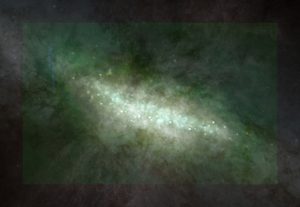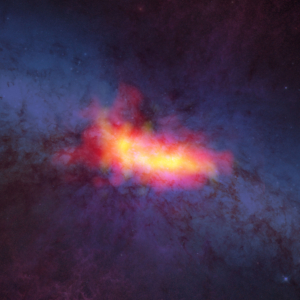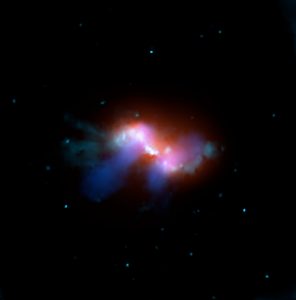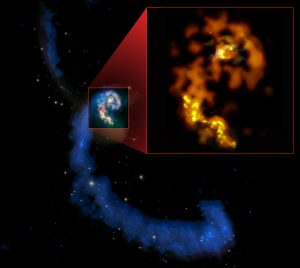The Cigar Galaxy, M82, is experiencing a furious phase of star formation. Clouds of gas and dust are collapsing into stars across the center of this galaxy, and the Very Large Array has mapped them here as bright points. Streaming out from many of the star-forming regions are the jets from giant young stars pushing charged, excess gas up and out of their accretion disks. This VLA radio image (tinted green) has been placed on top of an optical image from the Hubble Space Telescope.


M82 As Seen By the GBT
This composite image of starburst galaxy M82 shows the distribution of dense molecular gas as seen by the GBT (yellow and red) and the background stars and dust as seen by Hubble (blue). The yellow areas correspond to regions of intense star formation. The red areas trace outflows of gas from the disk of the galaxy.

Hercules A
The Very Large Array sees fountains of hot gas erupting from a beastly black hole in the heart of a large galaxy known to radio astronomers as Hercules A. For millions of trillions of miles, these jets shoot through space, finally slowing when they reach ancient gaseous hiccups left behind by this galaxy’s earliest days of star-forming fury.

The Black Hole in Radio Galaxy 3C 305
This bizarre galaxy has a supermassive black hole in its center. Data from three different wavelengths were used to create this composite image of galaxy 3C 305 in the constellation of Draco. The radio light, in blue, looks like headlights coming out of the galaxy and is caused by the magnetic field of the giant black hole.

ALMA First Image
In this composite image of the merging cores of the Antennae Galaxies, optical (white and pink), radio (blue) and millimeter/submillimeter (orange and gold) images are combined to show the history and future of star formation. The optical image represents stars that are shining now. The radio image highlights gas that is probably too thin to become a star, and at the mm/submm wavelengths we can see the areas where new stars will likely form.

Antennae Galaxies
Hard to believe that this was once a pair of spiral galaxies. Undergoing a violent merger, the well-named Antennae Galaxies are quite a spectacle to radio telescopes. In blue are the data from the VLA, showing the trails of hydrogen stripped from the outer arms of the two spirals. In orange and gold (inset) are the data from ALMA showing the areas of star formation caused by the collision of gas and dust clouds.





